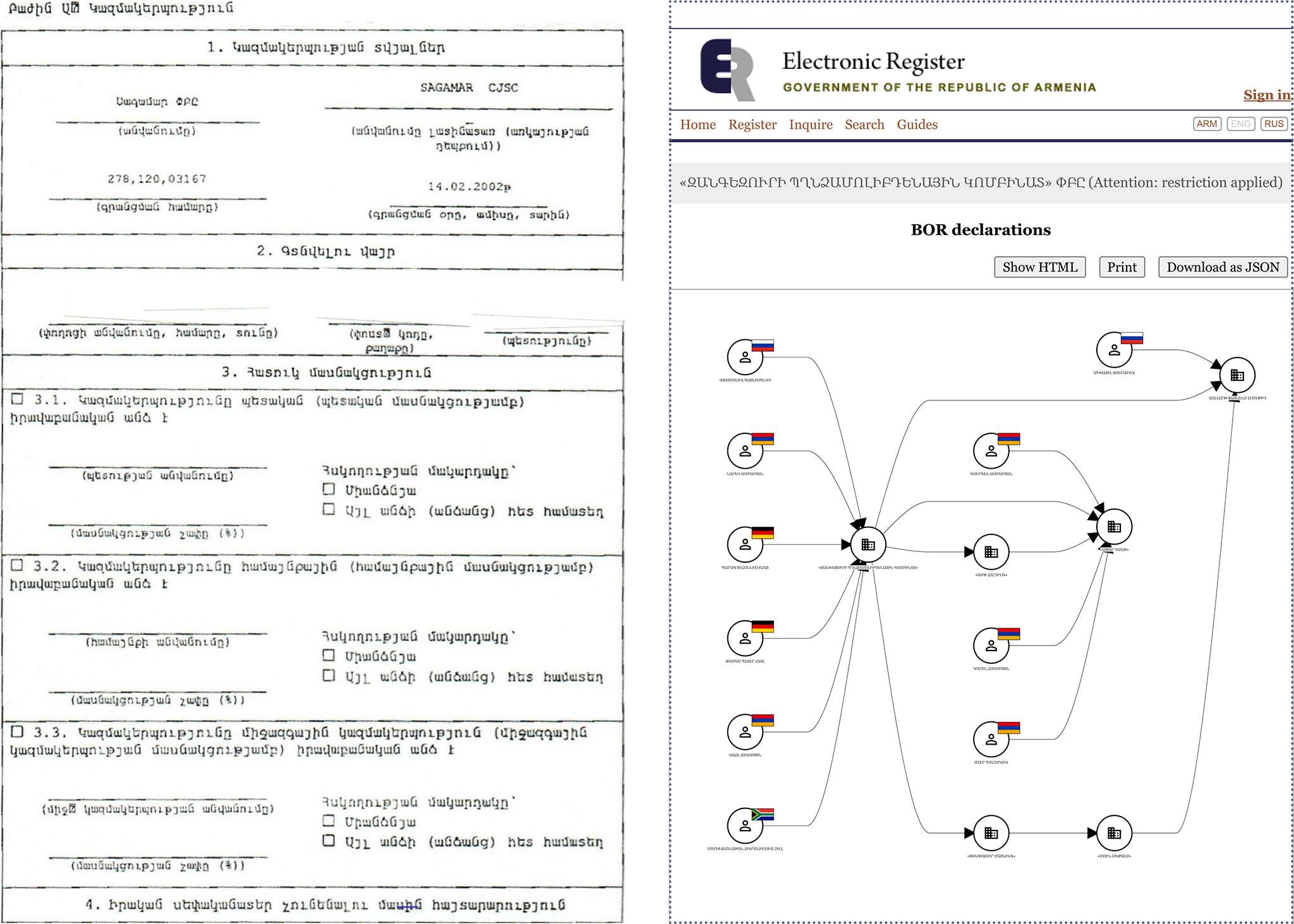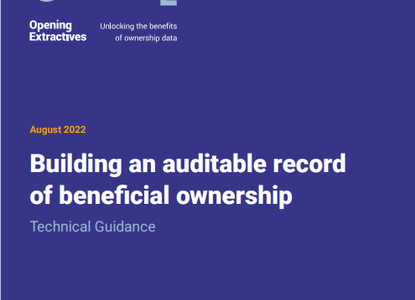Blog post on structured and interoperable BO data
One: improved functionality
It may sound obvious, but data is a lot easier to use if it’s organised. Imagine going into a supermarket that had all its stock randomly piled up on the floor. Even though you went in for apples, you might end up deeply frustrated, walking out with an orange. The unstructured data equivalent would be an analyst digging through a pile of papers where everyone had chosen what to declare, and described their ownership of companies in their own words. Meanwhile the analyst was supposed to get the data ready to share with another government agency, or even with international law enforcement. Not an enviable task.

Figure 1: An unstructured beneficial ownership declaration from 2018 (left) versus a structured declaration in 2022 (right), shown through the Beneficial Ownership Data Standard data visualiser on Armenia’s e-Register.
This is why at Open Ownership (OO) we spend a lot of time thinking about the best ways to organise (structure) data so that it can be most useful. This analysis is then fed into free guidance for people all over the world who are grappling with how to collect, store and analyse data on beneficial ownership. To complete this circle of activity, we produce technological products and tools (all free) which let people embark on these methods in their own country, to meet their own policy aims, and invite users to feed back into our data standard (more on that below).
OO’s new Structured and Interoperable Beneficial Ownership Data briefing starts by explaining to the reader as to why countries who collect and publish BO data as structured data will have so many more types of data analysis open to them. Countries that make use of the Beneficial Ownership Data Standard (BODS), can easily deploy a number of tools that have been developed for the standard. BODS is free, open-source and has a wealth of guidance and technical support available. If it is new to you, please go to standard.openownership.org if you would like to know more, or email [email protected].
The briefing then outlines three main benefits for countries that collect, store and publish structured data. Finally it explains how to implement it in practice. Today we will cover the first benefit: improved functionality.
It’s true of course that technical users of data love a data standard; information becomes predictable, it sits in a predefined structure, and so it is easy to work with. But one of the biggest benefits of structured data for society is that non-technical users can benefit from it too. Due to its ease of use, structured data can be made available in programmes, apps and on websites. This means a wide variety of people from government researchers, to investigative journalists, to international law enforcement can see the information in a variety of non-technical ways.
The briefing showcases some of the clear ways the structured data enables:
- searching and querying of BO data to find records of known people or companies
- bulk analysis of single or combined data sets to find patterns or red flags relating to beneficial ownership, or to assess and improve data quality
- automation of business processes that involve company ownership information, (for example, supplier onboarding and customer due diligence)
- converting complex information into user-friendly formats that are appropriate for a given context and audience
We’ll just give one example from numbers two and four here, but do read the full briefing to get a sense of what it is possible to achieve.
Bulk analysis: In 2016, the UK became one of the first countries to create a public register of the beneficial owners of companies. In 2017, Transparency International and Bellingcat conducted bulk analysis on Scottish Limited Partnerships (SLPs), an obscure type of legal business partnership that was initially not included within the disclosure requirements. They found that 71% of all SLPs registered in 2016 were controlled by companies based in secrecy jurisdictions. This analysis, combined with reporting on wide-scale abuses involving SLPs, led the UK to bring SLPs within the scope of its disclosure requirements. Subsequent bulk analysis showed a decline in SLP registration, suggesting the powerful deterrent effect of transparency.
Converting complex information into user-friendly formats: OO has built on a prototype developed by mySociety and Spend Network called Bluetail. What you can see below is an advanced example of what can be achieved in terms of user-friendly applications. Here, data published to BODS, and data published to the Open Contracting Data Standard are combined, and made to automatically raise red flags for corruption and collusion risks when procurement officers screen tenders.

Figure 2: The power of standardised data sets is shown to great effect in this example of a programme called Bluetail. It shows company ownership details, politically exposed persons, and red flags when companies apply for work by tender. Source: bluetail.herokuapp.com.
In summary, structured data is predictable, regardless of its origin. This makes collaboration and data use possible across lots of different organisations and jurisdictions, and data which is clear for many more people to use and analyse. In the next blog post in this series, we will discuss the cost benefits that can accrue to countries who collect and publish their data to BODS. We’ll show how the savings run right through the life cycle of information gathering, and include its maintenance, use and impact.

